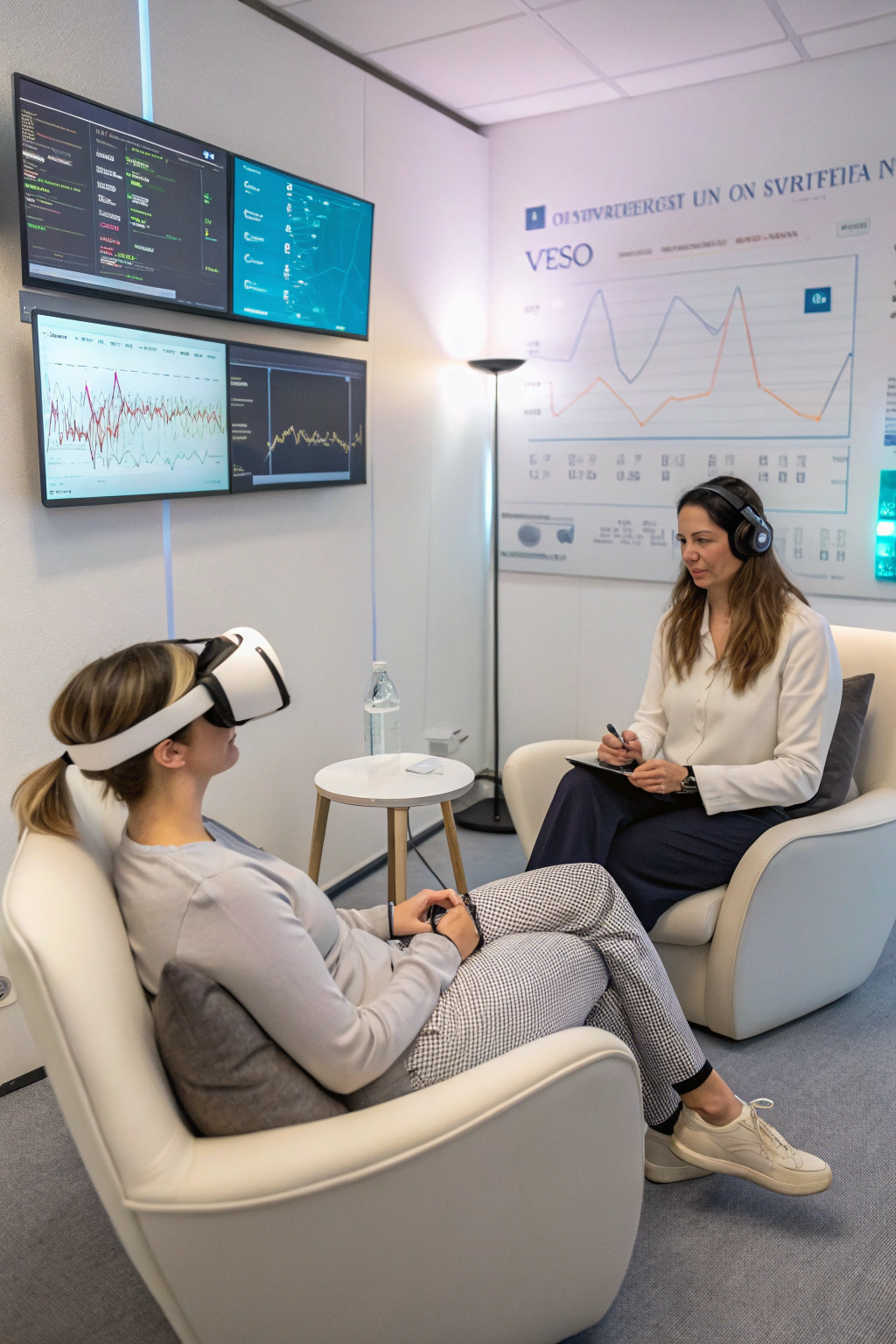Introduction
AI Mental Health is revolutionizing how we approach mental well-being by bringing therapy into immersive, digital spaces. The landscape of mental healthcare is undergoing a profound transformation, moving beyond the traditional therapist’s office into the virtual realm. At the forefront of this revolution lies the powerful convergence of AI and Mental Health in Immersive Therapy Worlds. These are not mere video games; they are intelligent, personalized environments designed to offer accessible, scalable, and effective mental wellness support. By harnessing artificial intelligence in virtual and augmented reality, we are unlocking new ways to treat conditions like anxiety, PTSD, and social phobias—creating safe digital spaces once confined to science fiction.
Background and Evolution of AI and Mental Health in Immersive Therapy Worlds
The story of AI Mental Health began decades ago. One of the earliest attempts at digital therapy was ELIZA, a 1960s chatbot mimicking a Rogerian psychotherapist. Though basic, it opened the door to future innovation. The rise of cognitive-behavioral therapy (CBT) apps on smartphones was a turning point, making mental health tools widely accessible. Meanwhile, virtual reality (VR) transitioned from military labs to the consumer market. The real breakthrough came when AI was integrated into VR therapy—creating environments that are not only immersive but also adaptive and context-aware. These smart systems personalize each session, transforming virtual therapy into a powerful new form of AI Mental Health intervention.
Practical Applications of AI and Mental Health in Immersive Therapy Worlds
Use Case 1: Dynamic Exposure Therapy for PTSD and Phobias
Exposure therapy, a cornerstone of treatment for anxiety disorders, involves gradually confronting feared objects or situations. Immersive worlds take this to an entirely new level of safety and control. A patient with a fear of flying can enter a hyper-realistic virtual airplane. The AI acts as a digital co-therapist, monitoring biometric data like heart rate and galvanic skin response. If the patient’s stress levels spike, the AI can dynamically reduce the stimuli—perhaps by calming turbulence or thinning the crowd of virtual passengers. This real-time adaptation ensures the patient remains within a therapeutic window, maximizing efficacy while minimizing the risk of re-traumatization.
Use Case 2: Social Skill Rehearsal for Autism and Social Anxiety
For individuals with social anxiety or on the autism spectrum, navigating social situations can be overwhelming. Immersive therapy worlds offer a consequence-free training ground. A user can enter a virtual café, job interview, or party populated by AI-driven avatars. These AI characters can simulate a wide range of personalities and conversational styles. The user can practice initiating conversations, interpreting social cues, and managing difficult interactions. The AI can provide immediate, non-judgmental feedback, highlighting moments of success and suggesting alternative approaches, building the user’s confidence for real-world encounters.
Use Case 3: Personalized Mindfulness and Resilience Training
Mindfulness and meditation are powerful tools for managing stress and improving overall well-being. The synergy of AI and Mental Health in Immersive Therapy Worlds elevates these practices. Imagine a guided meditation not in your living room, but in a serene, AI-generated forest that responds to your mental state. If EEG or heart rate data indicates a wandering mind, the AI might gently introduce a sound, a breeze, or a visual cue to guide your focus back. These bio-responsive environments create a deeply personal and engaging meditative experience, making it easier for users to achieve a state of flow and build lasting mental resilience.
Challenges and Ethical Considerations
Despite its immense potential, the deployment of AI in immersive therapeutic settings is fraught with challenges. Data privacy is paramount; the biometric and emotional data collected is incredibly sensitive and must be protected with robust encryption and transparent policies. Algorithmic bias is another significant concern. An AI trained on a narrow demographic might fail to understand or appropriately respond to the cultural or individual nuances of a diverse user base, potentially causing harm. There’s also the risk of technological over-reliance and the ethical dilemma of replacing human connection, which is often a critical component of healing. Without clear regulatory frameworks, we risk creating a digital mental health wild west, where quality and safety are not guaranteed.
What’s Next for AI and Mental Health in Immersive Therapy Worlds?
The future trajectory is incredibly exciting. In the short term, we’ll see more sophisticated AI co-therapists and a wider range of clinically validated, condition-specific modules. Mid-term, expect deeper integration with wearable biosensors (like EEG headbands and smart rings) for more precise emotional tracking and real-time environment adaptation. Startups like BehaVR and TRIPP are already pushing the boundaries here. Long-term, the vision points toward a persistent « wellness metaverse, » where users can seamlessly access a variety of therapeutic, coaching, and community support spaces as part of their daily routine. The development of AI and Mental Health in Immersive Therapy Worlds will focus on creating truly personalized, life-long mental wellness companions.
How to Get Involved
Stepping into this emerging field is more accessible than you might think. Start by exploring consumer-level VR wellness applications like TRIPP or Maloka on platforms like Meta Quest or SteamVR to understand the current user experience. For deeper technical or clinical insights, follow the work of researchers at institutions like Stanford’s Virtual Human Interaction Lab. Engage in online communities on Reddit, such as r/VRtherapy, to connect with developers and users. To stay updated on the broader applications of future technologies, you can always visit our hub for regular insights and analysis.
Debunking Common Myths
Myth 1: AI therapists will completely replace human therapists.
Reality: This is highly unlikely. The goal of these technologies is to augment, not replace, human care. They serve as scalable tools for support between sessions, for managing less acute conditions, or for providing access to care where none exists. The human element of empathy, intuition, and complex relationship-building remains irreplaceable.
Myth 2: It’s just a more advanced form of video gaming.
Reality: While they share a technology base (VR), the purpose and design are fundamentally different. Immersive therapy is built on evidence-based psychological principles like CBT and exposure therapy. Every element, from the environment to the AI interactions, is clinically designed to achieve a specific therapeutic outcome, not for entertainment.
Myth 3: This technology is only for treating severe mental illness.
Reality: A significant application area for AI and Mental Health in Immersive Therapy Worlds is in preventative care and general wellness. These platforms are powerful tools for stress management, resilience training, improving focus, and practicing mindfulness, making them beneficial for anyone looking to enhance their mental well-being.
Top Tools & Resources for AI and Mental Health in Immersive Therapy Worlds
- TRIPP: This is one of the leading consumer VR wellness platforms. It offers guided meditations and focus exercises in stunning, algorithmically generated worlds. It matters because it demonstrates the consumer appeal and potential for daily mental wellness routines in VR.
- Limbix: A pioneer in prescription digital therapeutics, Limbix develops VR kits specifically for clinicians to use with adolescents facing mental health challenges. It helps bridge the gap between technology and clinical practice, showing a clear path to FDA approval and insurance reimbursement.
- Psylia: A platform empowering therapists to create and customize their own VR therapy scenarios without needing to code. This is crucial for personalization, allowing a therapist to tailor an experience directly to their patient’s specific needs and therapeutic goals.

Conclusion
We are standing at the threshold of a new era in mental healthcare. The fusion of artificial intelligence and virtual reality is not a gimmick; it’s a legitimate and powerful new modality of treatment and wellness. As technology becomes more sophisticated and accessible, the use of AI in these immersive therapy platforms will grow, offering personalized, on-demand support to millions. While ethical guardrails are essential, the potential to democratize mental health support and create deeply effective healing experiences is undeniable. The digital couch is here, and it’s ready for its first session. 🔗 Discover more futuristic insights on our Pinterest!
FAQ
What is AI and Mental Health in Immersive Therapy Worlds and why is it important?
This refers to the use of artificial intelligence within virtual reality (VR) or augmented reality (AR) environments to provide mental health support. It’s important because it offers a scalable, accessible, and highly personalized way to deliver therapies like exposure therapy, social skills training, and mindfulness, overcoming geographical and social barriers to care.
How can I start using AI and Mental Health in Immersive Therapy Worlds today?
For individuals, the easiest entry point is through consumer VR headsets like the Meta Quest. You can download wellness applications such as TRIPP or Guided Meditation VR from the app store to experience the benefits of immersive mindfulness and stress reduction firsthand.
Where can I learn more?
You can follow leading academic bodies like the Virtual Human Interaction Lab at Stanford. For professional applications, look into companies like Limbix and BehaVR. Online communities on platforms like Reddit and LinkedIn dedicated to « VR for Health » are also excellent resources for news and discussion.
